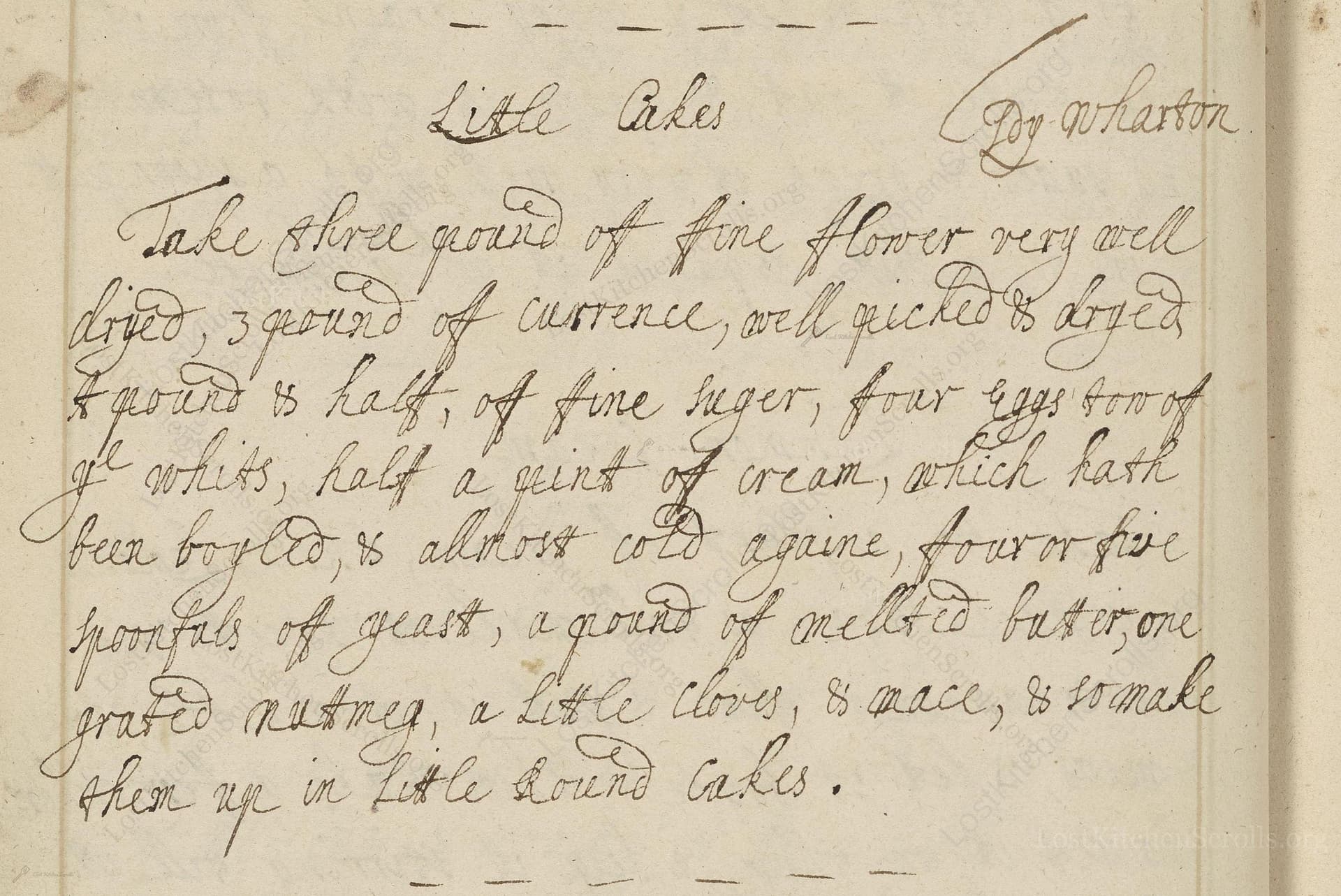Litle Cakes
From the treasured pages of Receipt book of Mary Hookes
Written by Mary Hookes

Litle Cakes
"Take three pound of fine flower very well dryed, 3 pound of currence, well picked & dryed, a pound & half of fine suger, four eggs tow of ye whits, half a pint of cream, which hath been boyled, & allmost cold againe, four or five spoonfuls of yeast, a pound of melted butterr, one grated nutmeg, a Litle cloves, & mace, & so make them up in Litle round cakes."
Note on the Original Text
This recipe, written in the late 1600s or early 1700s, uses period spelling and measurement: 'flower' for flour, 'currence' for currants, 'suger' for sugar, 'boyled' for boiled, and so on. Quantities are large and assume household cooks baking for a big family or staff. Methods are left implicit, as the expectation was that experienced cooks would know details such as kneading, rising, and baking, even if not spelled out. The recipe uses yeast for leavening—common before the invention of chemical raising agents—and blends the richness of eggs, butter, and cream for a luxurious, celebratory treat.

Title
Receipt book of Mary Hookes (1700)
You can also click the book image above to peruse the original tome
Writer
Mary Hookes
Era
1700
Publisher
Unknown
Background
A delightful voyage into the kitchens of the late 17th and early 18th centuries, this book teems with forgotten flavors, aromatic recipes, and the elegant wisdom of early modern cookery. A treasure trove for culinary adventurers craving a taste of the past!
Kindly made available by
Folger Shakespeare Library
This recipe comes from Mary Hookes, an Englishwoman active between 1675 and 1725, a period of rich domestic manuscript cookery in England. These 'Litle Cakes' reflect the festive baking habits of the middling and upper classes, who could afford imported currants, spices, and refined sugar. Recipes of this time were often written for household management by literate women or their servants, and intended for family gatherings and special events. Much like modern tea cakes, these little cakes speak of the cozy, sociable rituals of early modern English homes. The use of yeast as a leavening agent, rather than more modern baking powders, reminds us that these cakes were lightly risen, almost like a breakfast bread or enriched bun rather than a cake as we know it today.

In the 17th and early 18th centuries, this recipe would have been prepared with large mixing bowls (often wood or earthenware), a hand whisk or wooden spoon, brass or copper pans for melting butter and heating cream, and heavy baking sheets or tin trays scoured with sand. The cakes would have been shaped by hand and left to rise near the warm hearth. Baking would have taken place in a wood-fired oven with embers raked to one side, or possibly in a Dutch oven or bake kettle set over embers.
Prep Time
1 hr 40 mins
Cook Time
25 mins
Servings
36
We've done our best to adapt this historical recipe for modern kitchens, but some details may still need refinement. We warmly welcome feedback from fellow cooks and culinary historians — your insights support the entire community!
Ingredients
- 3 lbs plain flour (well dried)
- 3 lbs dried currants
- 1½ lbs granulated sugar
- 4 eggs (2 whole, 2 whites only)
- 1 cup heavy cream (scalded and cooled)
- ¼–⅓ cup fresh yeast (or 1½ packets instant yeast as substitute)
- 1¼ lbs (20 oz) unsalted butter (melted)
- 1 whole grated nutmeg
- Pinch ground cloves
- Pinch ground mace
- Pinch salt (optional, not specified but often added)
Instructions
- To recreate 'Litle Cakes', begin by preheating your oven to 350°F.
- In a large bowl, mix 3 lbs of plain flour (well-dried) with 3 lbs of dried currants and 1½ lbs of granulated sugar.
- In a separate bowl, whisk 4 eggs (using only 2 of the whites), and add 1 cup of heavy cream that has been brought to a boil and cooled to nearly room temperature.
- Stir in 1¼ lbs (20 oz) of unsalted butter, melted and cooled.
- Dissolve 4–5 tablespoons (¼–⅓ cup) of fresh yeast in a bit of lukewarm milk, then add to the wet mixture.
- Add a whole grated nutmeg, a pinch each of ground cloves and mace.
- Combine wet and dry ingredients, mix well—dough will be soft and enriched.
- Shape into small round cakes and place on lined trays.
- Let rise in a warm place until slightly puffy, then bake for 20–25 minutes until golden.
- The richness of butter, eggs, and cream, the spice, and the sweetness all point towards a festive or special-occasion treat, perfect for breakfast or teatime.
Estimated Calories
340 per serving
Cooking Estimates
Preparing 'Litle Cakes' takes about 40 minutes for mixing and shaping, plus 1 hour to let the dough rise. Baking takes 25 minutes. Each serving is about one small cake, and there are around 36 servings. Each cake has about 340 calories.
As noted above, we have made our best effort to translate and adapt this historical recipe for modern kitchens, taking into account ingredients nowadays, cooking techniques, measurements, and so on. However, historical recipes often contain assumptions that require interpretation.
We'd love for anyone to help improve these adaptations. Community contributions are highly welcome. If you have suggestions, corrections, or cooking tips based on your experience with this recipe, please share them below.
Join the Discussion
Rate This Recipe

Den Bockfisch In Einer Fleisch Suppen Zu Kochen
This recipe hails from a German manuscript cookbook compiled in 1696, a time whe...

Die Grieß Nudlen Zumachen
This recipe comes from a rather mysterious manuscript cookbook, penned anonymous...

Ein Boudain
This recipe comes from an anonymous German-language manuscript cookbook from 169...

Ein Gesaltzen Citroni
This recipe, dating from 1696, comes from an extensive anonymous German cookbook...
Browse our complete collection of time-honored recipes



